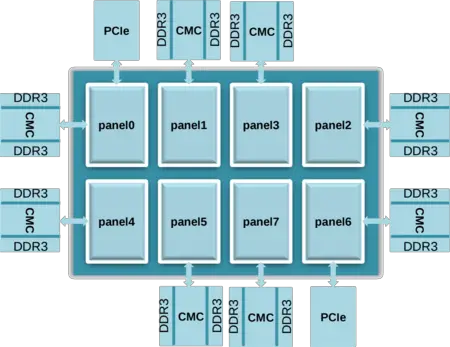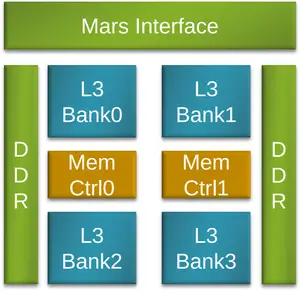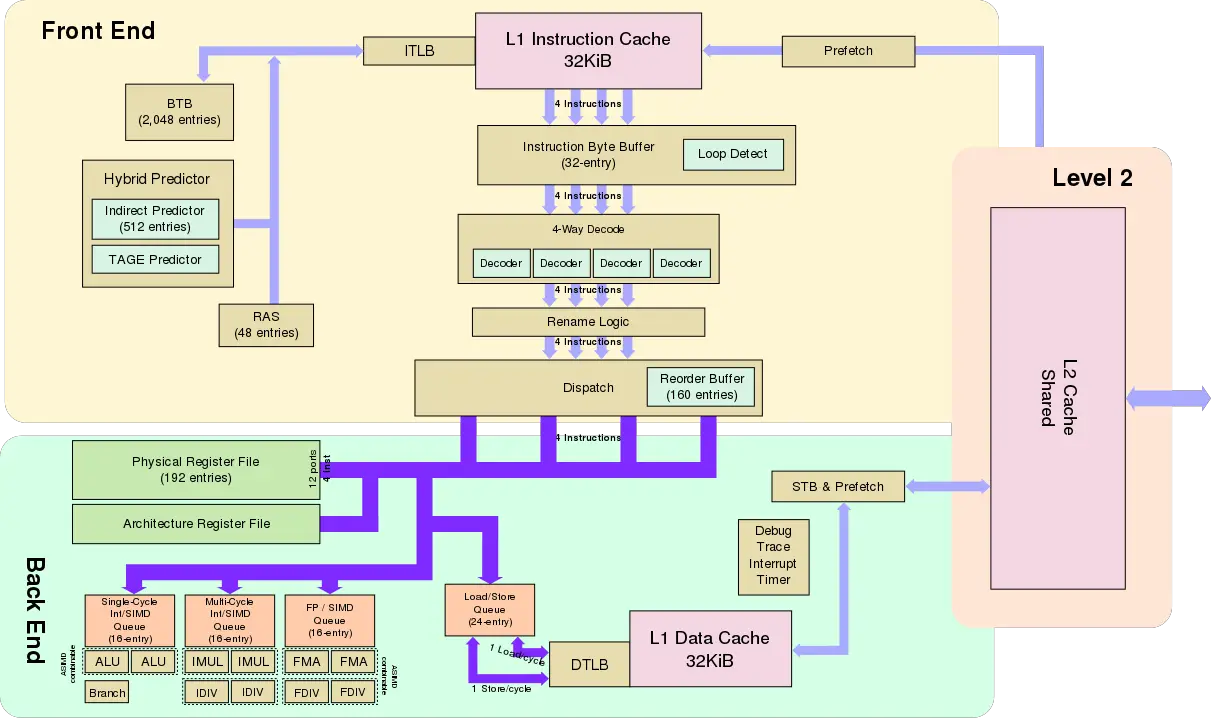(→Physical Design) |
(→Physical Design) |
||
| Line 183: | Line 183: | ||
|} | |} | ||
|} | |} | ||
| − | |||
| − | |||
| − | |||
| − | |||
| − | |||
| − | |||
| − | |||
| − | |||
| − | |||
| − | |||
| − | |||
| − | |||
== Performance Claims == | == Performance Claims == | ||
Revision as of 18:59, 16 March 2019
| Edit Values | |
| Xiaomi µarch | |
| General Info | |
| Arch Type | CPU |
| Designer | Phytium |
| Manufacturer | TSMC |
| Introduction | 2017 |
| Process | 28 nm |
| Pipeline | |
| Type | Superscalar |
| Speculative | Yes |
| Reg Renaming | Yes |
| Instructions | |
| ISA | ARMv8 |
| Cache | |
| L1I Cache | 32 KiB/Core |
| L1D Cache | 32 KiB/Core |
| L2 Cache | 4 MiB/Panel |
| L3 Cache | 16 MiB/CMC |
| Cores | |
| Core Names | FTC660, FTC661 |
Xiaomi is an ARM microarchitecture designed in-house by Phytium for their consumer market and server-based microprocessors.
Contents
Brands
| Codename | Brand | Description |
|---|---|---|
| Mars | FT-2000 |
|
| Earth | FT-1500A |
|
Architecture
Overview
- Fully ARMv8 compatible
- Support AArch32 and AArch64 modes
- EL0-EL3 supported
- ASIMD-128
- 28 nm process
- Scalable design
- 4 to 64 cores
- Mesh topology network-on-chip
- Panel-based (grid) architecture
- Global cache coherency
- 2x DDR3-1600 channels per panel
- ECC support
- 2x 16-lane PCIe 3.0
Panel Architecture
Phytium organizes their processors using a grid-layout they call Panels they call Panel-based data affinity architecture. Each panel consists of 8 independent ARMv8-compatible cores. Phytium "Mars" processor consists of 8 such panels for a total of 64 cores. Panels are interconnected with a 2-dimensional mesh network-on-a-chip level 2 cache with 4 MiB per panel for a total of 32 MiB.
In addition to the main die, Mars uses an additional Cache & Memory chips (CMC) auxiliary chips. "Mars" uses 8 such chips connected to the main die providing 16 MiB of level 3 cache for a total of 128 MiB as well as 8 dual-channel DDR3-1600 memory controllers for a total maximum bandwidth of 204 GiB/s. Mars also provides two 16-lane PCIe 3.0 interfaces. The chips incorporates ECC and parity protection on all caches, tags, and TLBs.
Panel
Each Panel consists of 8 cores - each ARMv8-compatible, supporting AArch32 and AArch64 modes, Exception Levels EL0-EL3, as well as ASIMD-128 operations. Each core has its own inclusive L1 cache and a shared L2 cache (4 MiB per panel). Each panel contains two Directory Control Units (DCU) which are in charge of maintaining directory-based cache coherency and one routing cell for managing the inter-panel communication.
On TSMC's 28 nm process, a panel is 6,000 µm x 10,600 µm (63.6 mm²).
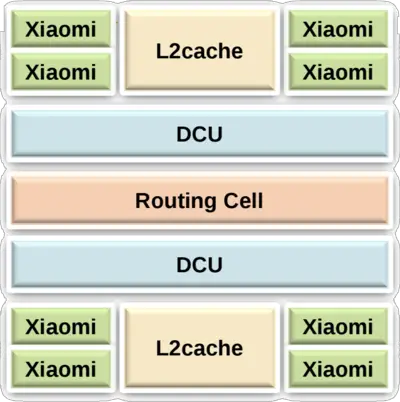 |
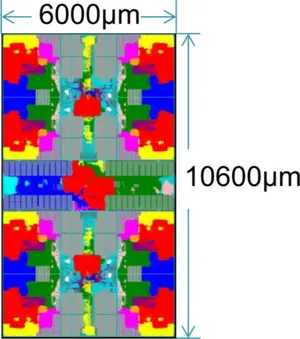
|
Cache & Memory Chip (CMC)
The solve the complexity involved in having more than eight memory controllers on a chip, Xiaomi uses a coupled auxiliary Cache & Memory Chip (CMC) to scale the bandwidth with computing power. In the case of Phytium "Mars" chip which contains 64 cores on 8 panels, eight CMC chips are used which provides 16 DDR3 controllers (8x2) along with 16 MiB of data L3 cache and 2 MiB of data ECC. Phytium proprietary interface is used between the processor and the CMC chip.
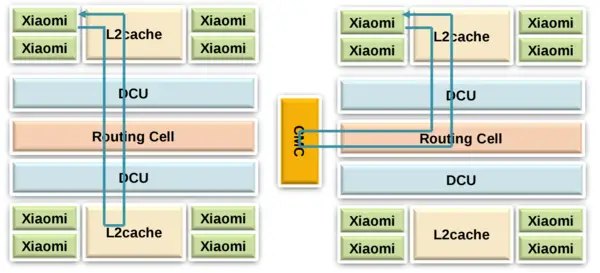 |
|
- Panel & NoC operates @ 2 GHz
- CMC operates @ 1.5 GHz
Block Diagram
Memory Hierarchy
- Cache
Pipeline
Each Xiaomi core is an ARMv8-compatible core implemented as a superscalar, out-of-order, 4-decode/4-dispatch pipeline with a hybrid branch prediction.
Front End
The front-end consists of the instruction caches & prefetches, fetching of instructions, and decoding. Xiaomi cores contain a 32 KiB L1 instruction cache with a prefetcher designed to reduce caches misses. On hits, 2 cycles are required for retrieval of instructions from the L1. Xiaomi has a hybrid branch predictor made of a TAGE predictor and a 512-entry indirect predictor. The BP unit also has a 48-entry Return Address Stack (RAS) for speculative subroutine return and a 2K-entry BTB. Up to four instructions can be fetches each cycle into the instruction buffer which is 32 entries in size.
The buffer is also a loop detection buffer, responsible for detecting loop patterns and hold them in the instruction buffer, bypassing the cache so they can be sent directly to decode. From the instruction buffer, up to four instructions can be decoded each cycle, up to four instructions can be renamed each cycle, and up to four instructions can be dispatched each cycle. Everything is done in-order up to this point.
Back End
The back-end performs operations out-of-order for the most part and is in charge of queuing instructions, executing them and retiring them. Dispatch contains a 160-entry ReOrder Buffer (ROB) and can dispatch up to 4 instructions per cycle. Note that over 210 instructions can be in-flight throughout the entire pipeline. Operand values can be read from Xiaomi's physical register file and an architectural register file in order to remove the various dependencies. Registers are only updated from the physical register file to the architectural register file when the corresponding instructions require. The physical register file contains 192 physical registers supporting up to four parallel instruction reads. Because ARM has instructions with up to four operands, the register file would need 16 ports to support those simultaneous instructions. To reduce some of the complexity, Phytium chose to reduce the number of ports to 12 where some of the ports are dedicated to each instruction and others are multiplexed. Phytium explained this decision resulted in a 2.5% reduction in area while adding 0.017% in overhead performance.
From dispatch, out-of-order instructions go into 4 discrete scheduling queues: 2x Integer/SIMD, 1x FP/SIMD, and 1x Load/Store. The Int/FP queues are each 16-entry deep. Xiaomi includes two separate Integer/SIMD queues. The first one is capable of executing two 64-bit single-cycle integer instructions or one 128-bit single-cycle integer (with the two units locked together). Additionally one of the units is also capable of performing branch operations. The second queue handles two multi-cycle integer/SIMD operations. Just like the single-cycle unit, the multi-cycle unit can also handle one 128-bit operation by combining both units. Xiaomi includes a single floating-point/SIMD queue with both units supporting FMA as well as two 64-bit FP operations or one 128-bit FP operation by combining two units.
The Load/Store queue is slightly larger than the Int or FP queues with 24 entries. Two loads or 1 load + 1 store can be issued each cycle. As with the level 1 instruction cache, the level 1 data cache is also 32 KiB supporting six outstanding loads. Next line and stride detected data prefetch are supported.
Interconnects & Hawk
Hawk is Pythium cache coherence protocol which implements a distributed directory-based global cache coherency across all the panels. Hawk is a MOESI-like package-based protocol. The network has a node on each panel called a Directory Control Unit (DCU) which is responsible for interfacing between the L2 caches in each panel to the CMCs (see § Panel Architecture). Phytium noted that it's optimized for exclusive atomic accesses.
Xiaomi implements a 2D concentrated mesh architecture on-die connecting each of the panels. Phytium "Mars" chip contains 8 panels which are organized in two rows of four panels each. Switching is relatively low latency with 3 cycles per hop. On average, packets will have around 9 cycles latency from any other panel. This network results in a bandwidth of 384 GiB/s each cell.
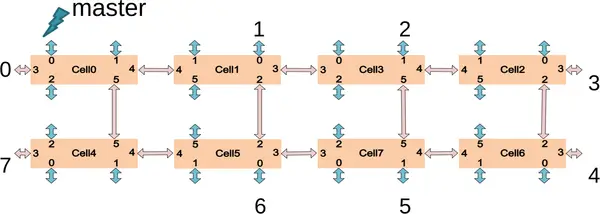 |
|
Performance Claims
| Int | FP | |
|---|---|---|
| SPEC_CPU2006_base (Single copy) |
19.2 | 17.8 |
| SPEC_CPU2006_rate (64 copies) |
672 | 585 |
References
- Zhang, C. (2015, August). Mars: A 64-core ARMv8 processor. In Hot Chips 27 Symposium (HCS), 2015 IEEE (pp. 1-23). IEEE.
| codename | Xiaomi + |
| designer | Phytium + |
| first launched | 2017 + |
| full page name | phytium/microarchitectures/xiaomi + |
| instance of | microarchitecture + |
| instruction set architecture | ARMv8 + |
| manufacturer | TSMC + |
| microarchitecture type | CPU + |
| name | Xiaomi + |
| process | 28 nm (0.028 μm, 2.8e-5 mm) + |
